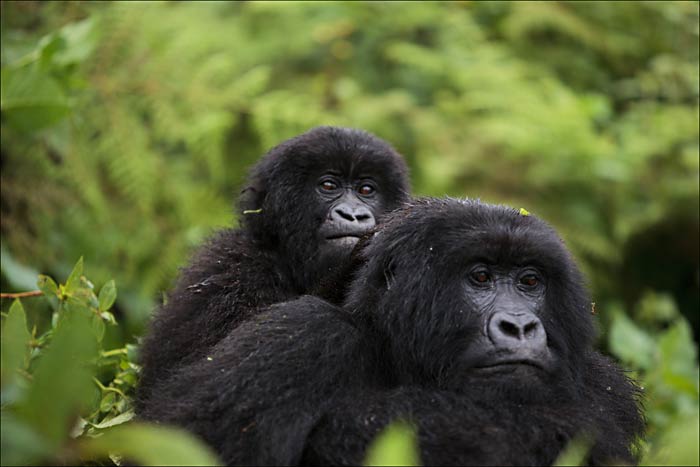Gland, Switzerland, 14 November 2018 (IUCN) – Conservation action has brought renewed hope for the Fin Whale and the Mountain Gorilla, according to today’s update of The IUCN Red List of Threatened Species. The Fin Whale has improved in status from Endangered to Vulnerable following bans on whaling, while the Mountain Gorilla subspecies has moved from Critically Endangered to Endangered thanks to collaborative conservation efforts.

Today’s IUCN Red List update also reveals that overfishing is causing fish species in parts of the developing world to decline, with 13% of the world’s grouper species and 9% of Lake Malawi fish now threatened with extinction. Overexploitation also threatens the Vene tree (Pterocarpus erinaceus) – an important source of timber – which enters The IUCN Red List as Endangered.
The IUCN Red List now includes 96,951 species of which 26,840 are threatened with extinction.
“Today’s update to The IUCN Red List illustrates the power of conservation action, with the recoveries we are seeing of the Fin Whale and the Mountain Gorilla,” says Inger Andersen, IUCN Director General. “These conservation successes are proof that the ambitious, collaborative efforts of governments, business and civil society could turn back the tide of species loss. Unfortunately, the latest update also underlines how threats to biodiversity continue to undermine some of society’s most important goals, including food security. We urgently need to see effective conservation action strengthened and sustained. The ongoing UN biodiversity summit in Egypt provides a valuable opportunity for decisive action to protect the diversity of life on our planet.”
Whale populations on the rise
Previously listed as Endangered, the Fin Whale (Balaenoptera physalus) is now listed as Vulnerable as the global population of the species has roughly doubled since the 1970s. The recovery follows international bans on commercial whaling in the North Pacific and in the Southern Hemisphere, in place since 1976, and significant reductions in catches in the North Atlantic since 1990. The status of the western subpopulation of the Gray Whale (Eschrichtius robustus) has also improved, moving from Critically Endangered to Endangered. Both of these whale species were historically threatened by overexploitation for their blubber, oil and meat.
“Fin Whales and Western Gray Whales were severely depleted by hunting, and it is a relief to finally see their populations on the rise. These whales are recovering largely thanks to bans on commercial hunting, international agreements and various protection measures. Conservation efforts must continue until the populations are no longer threatened,” says Randall Reeves, Chair of the IUCN SSC Cetacean Specialist Group. “These examples of governments, industry and civil society acting together for conservation should provide inspiration for Parties gathering in Egypt this week at the Convention on Biological Diversity conference.”
The nearly complete protection of Fin Whales throughout their range has allowed the global population to reach around 100,000 mature individuals. Western Gray Whales have been protected from commercial whaling in almost all range state since 1980, but only recently has there been clear evidence of increasing numbers in the western Pacific, particularly off Sakhalin Island, Russia. The delay between conservation measures taking effect and the detection of whale recovery is due, in part, to these animals‘ slow rate of reproduction. Five Gray Whale range states – Japan, the Russian Federation, the Republic of Korea, the USA and Mexico – have signed a Memorandum of Cooperation Concerning Conservation Measures for the Western Gray Whale Population. Industrial activity including oil and gas development and commercial fisheries also represent a potential threat to Gray Whales. Since 2004, an IUCN-led independent panel of scientists has been advising Sakhalin Energy, one of the largest companies operating offshore in the Russian Far East, on how to manage the potential impacts of its activities on the whales.
Hope for the Mountain Gorilla
This update of The IUCN Red List also brings hope for the Mountain Gorilla (Gorilla beringei beringei), which has improved in status from Critically Endangered to Endangered thanks to collaborative conservation efforts across country boundaries and positive engagement from communities living around the Mountain Gorilla habitat. The Mountain Gorilla is one of two subspecies of the Eastern Gorilla (Gorilla beringei); the Eastern Gorilla species remains Critically Endangered.
Intensive conservation action, including anti-poaching patrols and in-situ veterinary interventions – such as the removal of snares – has contributed to the growth of Mountain Gorilla populations since the previous IUCN Red List assessment, published in 2008. The 2008 Mountain Gorilla population was estimated to be around 680 individuals, but 2018 estimates show that it has increased to over 1,000 individuals, the highest figure ever recorded for the subspecies. The population growth has been confirmed through coordinated and improved survey methods.
Mountain Gorilla habitat is restricted to protected areas covering approximately 792 km2 in two locations in the Democratic Republic of the Congo, Rwanda and Uganda – the Virunga Massif and Bwindi-Sarambwe. Both locations are bordered by land intensively cultivated for agriculture by a growing human population. Threats to this subspecies remain high, including poaching, recurring civil unrest and human-introduced diseases, ranging from respiratory infections to Ebola.
“Whilst it is fantastic news that Mountain Gorillas are increasing in number, this subspecies is still Endangered and therefore conservation action must continue,” says Dr Liz Williamson of the IUCN SSC Primate Specialist Group. “Coordinated efforts through a regional action plan and fully implementing IUCN Best Practice guidelines for great ape tourism and disease prevention, which recommend limiting numbers of tourists and preventing any close contact with humans, are critical to ensuring a future for the Mountain Gorilla.”
read full article on www.iucn.org






